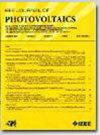Design and Development of a New Smart Portable I-V Tracer
IF 2.5
3区 工程技术
Q3 ENERGY & FUELS
引用次数: 0
Abstract
Photovoltaic (PV) module performance is primarily characterized by their current-voltage (设计和开发新型智能便携式 I-V 示踪器
光伏(PV)模块的性能主要由其电流-电压(I-V)测量值来表征。然而,获得的数据大多存在误差。商用 I-V 曲线跟踪装置通常价格昂贵、难以运输、响应速度慢,而且在低辐照度时受到限制。本文提出了一种基于优化单端初级电感转换器的新型 I-V 曲线跟踪器 (SEPIV)。SEPIV 包括一个连接到太阳能电池板输出端的线性可变直流负载。在这项研究中,SEPIV 的实验性能与商用和实验室设备的结果进行了比较,这两种设备分别是 PVPM 1000 C 40 (PVPM) 和 WAVELABS SINUS-3000 PRO。SEPIV 的准确度与实验室设备相当,并超过了 PVPM。与商用装置相比,SEPIV 测量不依赖于辐照水平。此外,它还具有物联网功能,可通过 Wi-Fi 连接进行远程测量。
本文章由计算机程序翻译,如有差异,请以英文原文为准。
求助全文
约1分钟内获得全文
求助全文
来源期刊

IEEE Journal of Photovoltaics
ENERGY & FUELS-MATERIALS SCIENCE, MULTIDISCIPLINARY
CiteScore
7.00
自引率
10.00%
发文量
206
期刊介绍:
The IEEE Journal of Photovoltaics is a peer-reviewed, archival publication reporting original and significant research results that advance the field of photovoltaics (PV). The PV field is diverse in its science base ranging from semiconductor and PV device physics to optics and the materials sciences. The journal publishes articles that connect this science base to PV science and technology. The intent is to publish original research results that are of primary interest to the photovoltaic specialist. The scope of the IEEE J. Photovoltaics incorporates: fundamentals and new concepts of PV conversion, including those based on nanostructured materials, low-dimensional physics, multiple charge generation, up/down converters, thermophotovoltaics, hot-carrier effects, plasmonics, metamorphic materials, luminescent concentrators, and rectennas; Si-based PV, including new cell designs, crystalline and non-crystalline Si, passivation, characterization and Si crystal growth; polycrystalline, amorphous and crystalline thin-film solar cell materials, including PV structures and solar cells based on II-VI, chalcopyrite, Si and other thin film absorbers; III-V PV materials, heterostructures, multijunction devices and concentrator PV; optics for light trapping, reflection control and concentration; organic PV including polymer, hybrid and dye sensitized solar cells; space PV including cell materials and PV devices, defects and reliability, environmental effects and protective materials; PV modeling and characterization methods; and other aspects of PV, including modules, power conditioning, inverters, balance-of-systems components, monitoring, analyses and simulations, and supporting PV module standards and measurements. Tutorial and review papers on these subjects are also published and occasionally special issues are published to treat particular areas in more depth and breadth.
 求助内容:
求助内容: 应助结果提醒方式:
应助结果提醒方式:


